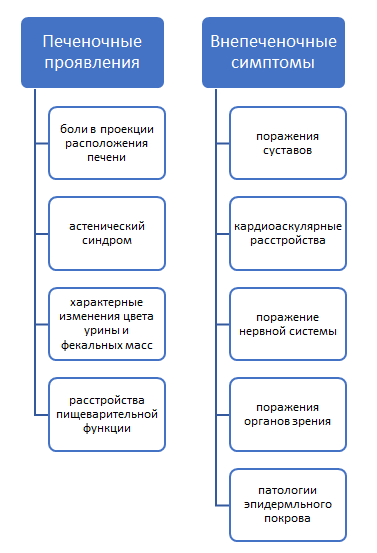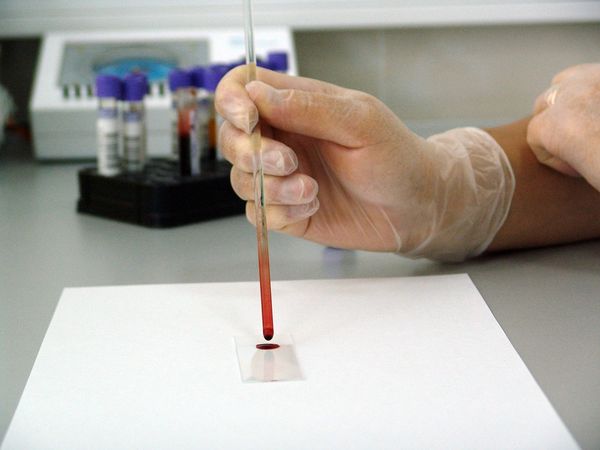Viral hepatitis C is a severe infectious liver disease characterized by a long, often latent course without a clear clinical picture with possible death. The patient’s death occurs not from the virus, but from complications caused by it, the most severe of which is malignant degeneration of liver cells. The first symptoms of hepatitis C in men are nonspecific, but being able to recognize the disease in time is very important. Treatment started at an early stage of pathology has a favorable prognosis and high efficiency.
The problem with the diagnosis and subsequent treatment of hepatitis C is that symptoms of a viral infection may either not occur at all, or appear already with severe liver damage. Many men do not pay attention to them because of their similarity to ARVI, banal poisoning or indigestion.
The person continues to lead a normal lifestyle, does not give up bad habits, continues to consume alcohol, and does not follow a diet. These factors provoke rapid necrosis of hepatocytes. As a result, they are replaced by connective tissue, which affects both the functioning of the liver and the state of health in general.
Experts cannot explain the mechanism of extrahepatic complications of hepatitis C. But a number of autoimmune disorders, pathologies of the epidermis, exocrine glands, and organs of vision are associated with the disease. It is believed that these diseases are caused by viral RNA circulating in the blood, insufficient filtering function of the liver, and portal hypertension.
But the connection between hepatitis C and such severe pathologies as cirrhosis and/or hepatocellular carcinoma has been reliably established. Sometimes HCV is diagnosed in men at a late stage, when there are all indications for liver transplantation.
Men of certain professions regularly undergo medical examination, which involves a full examination of the body, laboratory tests, including tests for hepatitis C. Others are advised to periodically consult a doctor or take the necessary tests themselves in a private laboratory, especially if even non-specific symptoms of hepatitis C appear.
Features of the disease and methods of transmission
The main structural units of the HCV virus are certain proteins and nucleotides. They form RNA, as well as a number of other subunits, each of which performs a specific, unique function. Thanks to this structure, the pathogen can inhibit the activity of the human immune system, the production of specific antibodies, and almost freely penetrate liver cells, disrupting their full activity and life cycle.
But the structure of the virus is not the same. The existing differences have allowed doctors to identify several genotypes of HCV. Until recently, a person was diagnosed with one of 6 genotypes. In recent years, reports about the possible existence of a seventh have increasingly appeared in the professional literature. Each of the known genotypes has up to 10–15 subtypes, which are designated by letters of the English alphabet.
Despite the diversity of HCV genotypes and subtypes, in practice, in Russia, specialists usually encounter 4–5.
Differences in the structure of the virus also determine differences in the development of the disease. The symptoms of HCV varieties are similar, but the progression of liver pathologies with genotype 3 occurs much faster. And type 1b tends to rapidly transition into the chronic phase.
The routes of infection with hepatitis C do not depend on a specific genotype. The main method of transmission is parenteral, that is, when the blood of a healthy person comes into contact with an infected person.
It is important
Experts consider the African continent to be the “homeland” of HCV. It is believed that initially the main reason for the rapid spread of infection was the customs of local tribes to exchange blood, apply scars to the body, perform magical rituals related to blood, etc. This hypothesis also explains the emergence of hepatitis C in America and Europe with the beginning of the slave trade, as well as the era of active migration between continents.
A man can become infected in the following ways:
- when visiting a tattoo parlor;
- when visiting the dentist;
- when using shared syringes (this applies to representatives of the stronger sex with a pathological dependence on injecting drugs);
- during sexual intercourse, especially during anal sex;
- when using hygiene items (for example, razors) with remains of infected blood;
- when carrying out various medical procedures (blood sampling, endoscopy, biopsy, placing IVs, performing injections) using non-sterile instruments.
The virus exhibits resistance in the external environment: it can remain infectious for several days in blood spilled on linen, clothing, towels, and objects. The everyday route of infection is unlikely, but is theoretically possible, for example, when trying to stop bleeding with a soiled cloth.
In addition, the general health of a man is of great importance. The risk group includes representatives of the stronger sex with a weakened immune system for some reason or with liver disease. The risk of infection through contact with the virus increases with alcohol abuse, poor diet, and bad habits. Hepatitis C is often diagnosed in men with HIV/AIDS.
Routes of infection and causes
The main route of transmission of the virus from a carrier to a healthy person is parenteral (through venous access and blood). It must be remembered that infection can also occur through the exchange of other fluids: semen, saliva, urine. For a healthy person to become infected with hepatitis C, the virus must enter the bloodstream. The main category of hepatitis C carriers are injection drug addicts. When using a drug with one syringe at the same time by several people, an exchange of the hepatitis C virus can occur. Drug addicts are also dangerous from an epidemiological point of view when the spread of hepatitis in their social circle (other drug addicts, relatives) occurs rapidly. Almost 80% of all patients with hepatitis C are injection drug addicts.
| Progression of the disease over time |
|
In addition to drug addiction, you can become infected with hepatitis C in other ways:
- blood transfusion;
- hemodialysis (renal replacement therapy);
- dental treatment;
- donation;
- surgical endoscopic examinations;
- organ transplantation (from a patient with hepatitis C to a recipient);
- sharing razors and toothbrushes;
- manicure or pedicure;
- tattooing and more.
In any case that involves contact with blood, there is a chance of becoming a carrier of hepatitis C. The virus can also be transmitted sexually, but here the danger is posed by the secreted fluid, which can get onto injured areas of the mucous membrane during unprotected sexual intercourse. Sexual transmission is extremely rare, but real. This must be remembered. Infection of the fetus in the womb is possible only during delivery (passage through the birth canal). The hepatitis C virus does not affect reproductive function and a healthy child can be born. The basis for a successful birth is the degree of viral load on the mother’s body.
Symptoms of hepatitis C in men
The incubation period ranges from 3 weeks to 5 months, but on average does not exceed 50 days. In the acute course, HCV is diagnosed extremely rarely, since usually the disease occurs in a subclinical anicteric form or without symptoms or with a blurred clinical picture.
In 95% of cases with acute hepatitis C, there are no external signs in men.
Subsequently, the picture of how the virus manifests itself is associated with the progressive replication of HCV in the body. Gradually emerging symptoms of the disease can be divided into two groups - hepatic and extrahepatic. The former are usually noted in the early stages of a viral infection, the latter - during a long-term chronic course.
Symptoms of hepatitis C in men are:

The intensity of the first symptoms of hepatitis C infection, as well as the manifestations of the disease in the later stages, are individual for each man. In some, the pathology manifests itself with a clearly defined clinical picture, while in others it occurs latently for decades, with virtually no reminder of itself.
How does the virus manifest itself in the early stages?
With hepatitis C, the first signs of infection are not very convincing.
Symptoms of infection include:
- weakness;
- lethargy;
- rapid fatigue (especially against the background of habitual physical activity and daily routine);
- decreased exercise tolerance.
The acute form of HCV at the pre-icteric stage may be accompanied by:
- feeling of heaviness, discomfort in the right hypochondrium;
- fever: the temperature rarely rises above subfebrile values;
- dyspeptic manifestations: heaviness in the stomach, flatulence, stool disorders, belching with a bitter taste.
With a high viral load (rapid, rapid spread of the virus in the body), extrahepatic symptoms may be added to the manifestation of hepatitis C in the early stages in men - aching joints, sensory disturbances in peripheral nerves.
If you take a general clinical blood test during this period, pay attention to the decrease in the level of leukocytes and platelets. Other indicators may not be outside the normal range. However, the acute form of HCV usually causes changes in liver tests - the level of alanine aminotransferase increases. In the study form it is designated as ALT.
Extremely rarely (for example, with progressive HIV), HCV manifests itself with extrahepatic manifestations - severe forms of aplastic anemia, agranulocytosis, peripheral neuropathy. In such cases, death is possible even before the production of enough antibodies to be determined by laboratory methods.
Manifestation of chronic disease
Symptoms of chronic hepatitis C in men develop in 80% of cases after suffering from an acute form. Clinically, the pathology may not manifest itself for a long time, but often the patient is bothered by a constant feeling of fatigue and weakness (asthenic syndrome).
The chronic form of viral infection (CHC) often occurs against the background of extrahepatic symptoms, the severity and intensity of which decreases when taking appropriate medications.
According to experts, the true incidence of extrahepatic complications may be overestimated, since it is almost impossible to establish which diseases existed before infection and which appeared after.
CHC is characterized by:
- pain in the right hypochondrium of varying intensity, from sensations at the level of discomfort to severe attacks, especially after violations of diet or physical activity;
- a persistent decrease in food cravings and, as a result, rapid weight loss;
- change in the shade of feces (they become light, sometimes grayish) and urine (they become dark, brownish) due to an increase in the level of total bilirubin;
- fluctuations in body temperature, fever can appear “out of the blue”, for no apparent reason, and disappear just as abruptly; usually the scale on the thermometer does not rise above 37.5–37.6°;
- discomfort in the eyes and mouth associated with the feeling of drying out of the mucous epithelium;
- myalgia;
- neuropathy;
- headaches similar in intensity and symptoms to migraines;
- memory and concentration disorders;
- sleep disorders;
- vascular network and asterisks;
- intense hair loss, thinning, loss of shine;
- skin itching, rash;
- skin pigmentation disorder;
- manifestations of autoimmune thyroiditis (excessive sweating, nervousness, irritability);
- arthralgia.

Symptoms of exacerbation of chronic hepatitis C are similar in clinical course to the acute form of HCV. The patient’s well-being deteriorates, and yellowness of the skin and sclera often occurs (it can be either pronounced or insignificant and quickly disappear).
CHC is easily diagnosed by serological and molecular methods. But in some men, liver test parameters either do not go beyond the normal range or slightly exceed it.
The natural course of chronic hepatitis C is characterized by slow progression only in the absence of provoking factors. These include HIV, alcohol consumption, increased iron levels in the body, obesity).
With a healthy lifestyle, the development of cirrhosis in men occurs within 20–25 years from the moment of infection, which increases the value of timely diagnosis of the disease.
Complications and severe course of the disease
The progression of hepatitis C is associated with the development of various autoimmune pathologies.
- Systemic vasculitis (Behçet's disease) . It is accompanied by inflammatory damage to the main and peripheral blood vessels, which causes swelling, disturbances of peripheral sensitivity, ulceration of the mucous epithelium of the genital organs, oral, nasal cavity, cornea, and, less often, the digestive tract. The patient is also concerned about rashes of various locations.
- Arthritis . Autoimmune inflammatory damage to the cartilage tissue of the musculoskeletal system. Symptoms of the disease are pain in the area of first small, then large joints, stiffness (especially immediately after waking up), spontaneous increases in temperature, and rash.
- Skin itching . May be present as an independent complication. Occurs as a result of the accumulation of bile acids and disruption of the filtration function of the liver. The patient is bothered by severe, almost unbearable itching of the epidermis, which is often accompanied by psycho-emotional disorders.
- Cryoglobulinemia . The pathology is provoked by disturbances in protein metabolism, resulting in the deposition of peripheral proteins on the inner lining of the vascular wall. This provokes symptoms of systemic vasculitis (rash, itching); the kidneys are often affected with the development of autoimmune glomerulonephritis.
- Fibromyalgia and arthralgia . In men, it manifests itself as increased pain in the muscles (any location) and joints. Discomfort intensifies against the background of physical exertion and fatigue. The syndrome is usually accompanied by impaired peripheral tactile sensitivity, hematomas, and changes in emotional status.
- Corneal damage . It is a consequence of liver dysfunction in men. As a result, the likelihood of spreading necrosis and subsequently complete or partial blindness increases.
- Raynaud's syndrome . In men, both an independent disease and a complication of autoimmune damage to the musculoskeletal system appear. It manifests itself as a pathological reaction to cold - inflammation of the joints, discoloration of the skin, pain, and disturbances in nerve sensitivity.
The likelihood, as well as the rate of development of hepatitis C complications in men, varies from person to person. Therefore, if disturbing symptoms appear, you should not make a diagnosis based on a photo on the Internet. You need to make an appointment with a doctor and undergo a series of tests. Results are usually ready within 1-5 days.

Life expectancy with hepatitis C
The virus itself cannot be considered deadly for humans, because it only provokes pathogenic changes in the structure of the liver (contour and morphological). As the disease progresses, the virus only worsens the health of the infected patient.
The lifespan and period of destruction depends entirely on the following factors:
- age criterion of the patient;
- duration of the disease;
- state of immune defense;
- patient's quality of life;
- presence of bad habits;
- adequate therapy;
- the presence of concomitant chronic diseases.
On average, approximately 20-25 years pass from the onset of the disease to serious complications in the form of cirrhosis. By following the right lifestyle, you can significantly slow down the progression of the disease and maintain health until old age.
How the virus manifests itself: forms of HCV
Depending on the clinical picture and symptoms, hepatitis C can be divided into several groups. In some men, HCV has mixed symptoms.
Anicteric
2/3 of cases of diagnosed hepatitis C in men occur in the anicteric form. Against the background of this type of disease, liver test results may remain within normal limits for a long time. In this case, the color of the skin and sclera of the eyes does not change.
Sometimes patients complain of:
- constant weakness;
- flu-like symptoms;
- manifestations from the digestive tract;
- discomfort in the muscles and joints.
Ultrasound examination reveals a change in the size of the liver (in the vast majority of men), less often - in the spleen (in half of the patients).
Jaundice
Occurs in every fourth man diagnosed with hepatitis C with high viral loads. Yellowing of the skin and sclera is noted, which quickly disappears during acute infection. With an exacerbation of the disease, these symptoms appear again and are accompanied by an increase in the activity of liver enzymes (according to the results of laboratory tests).
Erased
Occurs most often. Develops after acute hepatitis C. It can last for 5–10 years without a pronounced clinical picture. One of the manifestations is asthenic syndrome. Due to liver damage and increased levels of liver enzymes, changes in the color of urine, feces, and discomfort in the right hypochondrium are likely.
Latent
The latent form is characteristic of the first genotype of HCV. The disease may not manifest itself for 20–30 years. It is usually diagnosed against the background of serious complications, therefore it is considered the most dangerous form of viral infection. Symptoms of pathology occur from time to time. After consuming fatty or fried foods, alcohol, against the background of weakened immunity due to acute respiratory viral infections or other diseases, a man may be bothered by pain in the right hypochondrium, belching, attacks of nausea, and an unpleasant taste in the mouth.
Cholestatic
It is rare in men. It develops against the background of complications of hepatitis C. As a result of dysfunction of hepatocytes and a progressive inflammatory process, compression of the gallbladder ducts occurs. It manifests itself in the form of attacks of pain in the right hypochondrium, deterioration of health, fever, yellowing of the epidermis (mainly in the folds of the skin), lack of appetite, and an unpleasant taste in the mouth. Discoloration of stool is characteristic.
Atypical
It occurs with a variable clinical picture and may include symptoms of all forms of hepatitis C. Rapidly passing periods of jaundice are noted against the background of weakness and a slight increase in body temperature. Symptoms from the gastrointestinal tract associated with digestive disorders are more pronounced.

Symptoms of the chronic form of the disease
After viral hepatitis C becomes chronic, the symptoms intensify. This is explained by the replacement of healthy tissue with connective fibers. Fibrous changes affect important liver functions, causing irreversible pathological processes to occur. One of them is cirrhosis of the liver.
The following symptoms may be observed:
- Accumulation of free fluid in the abdominal cavity. Ascites occurs in decompensated cirrhosis due to the functional failure of the organ.
- Difficulty breathing and shortness of breath. It is difficult for a man to climb stairs and walk at an accelerated pace.
- Swelling of the limbs. Due to impaired metabolism and increased pressure in the liver, there is stagnation of water in the body. As a result, a man develops varicose veins.
- Hemorrhagic manifestations in the form of pinpoint bruises. The vessels under the skin burst, forming small hematomas in the form of small stars. Subsequently, bleeding of the gums and internal organs is observed.
- The urine becomes a rich brown color with a little foam, and the stool turns white.
- Pain occurs in the hypochondrium due to the enlargement of the liver.
- In some cases, neurological symptoms of the brain occur due to intoxication. After memory loss, the patient stops orienting himself in space.
- The final outcome is liver failure. Complete liver failure is fatal.
These symptoms indicate a severe course of the disease, which requires immediate medical intervention, including a healthy liver transplant.
Diagnosis and treatment of HCV
Diagnosis of viral hepatitis C takes place in several stages. Some tests are re-ordered to definitively confirm the disease.
When a man develops characteristic symptoms, the following is prescribed:
- tests that determine the level of bilirubin, the main liver enzymes;
- ELISA to detect antibodies, the production of which begins in response to the entry of a pathogen into the blood;
- PCR is the most accurate diagnostic method, as it allows not only to determine the presence of viral RNA in the blood, but also to assess the severity of the disease.
Other general clinical examinations aimed at assessing general health are also required for men. The list of tests includes donating blood for HIV and other types of viral hepatitis.
It is best to begin treatment of hepatitis C in men soon after the first symptoms appear. In this case, experts give an almost 100% guarantee of complete recovery. The combination of Interferon and Ribavirin (used until the early 2000s) was replaced by direct-acting antiviral drugs. Their main difference is that they stop the virus replication process itself.
The list of the main active ingredients included in the medications of this class includes sofosbuvir, ledipasvir, velpatasvir. Only expensive original drugs (Sovaldi, Daklinza, etc.) are available on the domestic pharmaceutical market. But many patients are successfully treated with cheaper generics made in India.
Indications for the additional use of Interferon and Ribavirin are severe complications of the pathology - cirrhosis, hepatocellular carcinoma. Sometimes a liver transplant is recommended before starting therapy. Worsens the course of treatment and the prognosis for the development of HCV coinfection, especially HIV, hepatitis B.
Health implications
The disease is more dangerous due to its complications. These include: liver cirrhosis, primary liver cancer, endocrine pathologies (diabetes mellitus), anemia, systemic diseases. These conditions have a number of negative consequences for men. They significantly reduce the quality of life and reduce its duration.
Anemic syndrome significantly worsens the course of the disease. It may be a consequence of decreased production of blood clotting factors, as well as increased breakdown of red blood cells.
Considering all these factors, it is necessary to know in detail how hepatitis C manifests itself in men in the early stages, and be regularly tested, especially in risk groups.
The effect of hepatitis C on male potency
HCV itself does not have a negative effect on the functioning of the genitourinary system in men. But the symptoms of hepatitis C include chronic fatigue, nausea, vomiting, pain, discomfort, which does not have the best effect on potency and libido. Modern drugs used to treat infection are usually well tolerated and do not cause significant adverse reactions.
The course of therapy lasts from 12 to 24 weeks. But, as a rule, by the end of the first month of taking medication, a man’s well-being improves significantly, libido and potency are completely restored. The exception is interferon therapy regimens, which often provoke drowsiness, weakness, and heart rhythm disturbances.
Incubation period of viral infection
The entire incubation period of hepatitis C in men is asymptomatic. During this period of time, even laboratory tests can be false negative. There are also no changes in the liver or other organs.

Duration
On average, the incubation period lasts 7 – 9 weeks, but can vary from 2 to 24 weeks. This depends on the condition of the liver, its ability to recover and the strength of the immune response to the virus.
How can you understand that a person is sick?
Symptoms in men in the early stages are nonspecific; it is almost impossible to suspect hepatitis. A clue could be recent contact with blood or suspicious sexual intercourse. Clinical manifestations and laboratory results can be expected after 1 month. Until this date they will not be indicative.
Indicators of the chronic course of the virus
Signs of chronic hepatitis C are characterized by extrahepatic manifestations, the severity of which in men correlates with the time elapsed since infection. Such manifestations are caused by both an autoimmune reaction to the presence of pathogenic particles in the body and the progressive accumulation of toxins against the background of impaired liver function.
Signs of this form of the disease in men include:
- pain (of varying degrees of intensity in muscles, joints);
- damage to the organs of vision;
- disorders of peripheral nervous sensitivity, manifested in the form of tingling, itching of the skin of the fingers and toes;
- skin rash and itching.
Signs characteristic of the chronic form of hepatitis C in men also include:
- frequent headaches;
- weakness, fatigue, exercise intolerance;
- psycho-emotional disorders (constant mood swings, depression, irritability);
- transient jaundice;
- progressive deterioration of appetite, weight loss, asthenic syndrome, anemia, manifestations of vitamin deficiency (hair loss, violation of the integrity of the nail plate, susceptibility to fungal and viral diseases).
Pain in the area of the right hypochondrium is typical. If a man is unaware of his diagnosis and does not follow a diet, an exacerbation occurs after consuming food or alcohol that is difficult for the liver. Deterioration in well-being can be caused by stress factors, insufficient rest time, and overwork.

Clinical manifestations of complications
According to long-term observations of men with hepatitis C, it has been established that the average time for the development of cirrhosis is up to 15–20 years after infection. Fibrosis develops after approximately 5–10 years. It takes about 25 years for a malignant tumor to form. But this period is shortened if the liver is constantly exposed to the negative influence of alcohol, poor diet, and medications. Hepatitis C in men is also characterized by other complications associated with impaired blood flow in the organ, endocrine regulation, and metabolic disorders.
Portal hypertension
Signs of portosystemic collateral formation:
- The veins of the anterior abdominal wall are dilated.
- Venous pattern on the sides.
- Tortuous paraumbilical collateral veins.
- Rectal hemorrhoids.
- Ascites.
- Paraumbilical hernia.
Signs of a hyperdynamic state of blood circulation:
- Limiting impulses.
- Warm, well-perfused extremities.
- Arterial hypotension.
- Pericardial flow noise.
Other signs of portal hypertension and esophageal varices:
- Pallor. May suggest active internal bleeding.
- Enlargement of the parotid gland. May be associated with alcohol abuse or malnutrition.
- Cyanosis of the tongue, lips and periphery due to low oxygen saturation.
- Dyspnea, tachypnea.
- Vasodilation.
- Reduction in liver size.
- Fetor hepaticus (characteristic breath of patients with severe hepatic parenchymal disease, smelling like a mixture of rotten eggs and garlic): Occurs with portosystemic encephalopathy from any cause (eg, cirrhosis).
- Venous hum: A continuous murmur heard in patients with portal hypertension. May be present as a result of rapid turbulent blood flow in collateral veins.
- Tarry stools: suggests bleeding from the upper gastrointestinal (GI) tract.

Diabetes
Metabolic disorder can occur against the background of indolent hepatitis C. Diabetes therapy is carried out in parallel with an antiviral course. But such a complication is irreversible, and even after recovery you have to monitor your blood sugar levels and take appropriate medications.
Signs of diabetes include:
| External manifestations | Laboratory |
| Dry skin in tandem with persistent itching | Increase in glycated hemoglobin more than 6% (7 mmol/l) |
| Constantly pursuing a feeling of thirst, patients describe their sensations with the words “impossible to get drunk” | The glucose tolerance test shows values greater than 5.5 mmol/l in the first sample, and more than 7.8 mmol/l in the second |
| Dizziness | Fasting blood glucose >5.5 mmol/L |
| Edema | |
| Weight change | |
| Frequent urination (especially at night) | |
| Increasing the time required for healing of even minor skin damage | |
| Frequent fungal infections of the feet and nails | |
| Constantly occurring urogenital infections | |
| Increased blood pressure | |
| Peripheral neuropathies |
Encephalopathy of hepatic etiology
The pathogenesis of the complication is caused by disturbances in the central and peripheral blood flow and the accumulation of toxic metabolic products. Encephalopathy is characterized by psychoemotional disorders of varying severity. The pathology occurs in more than half of men with decompensated cirrhosis.
In case of encephalopathy due to hepatitis C, it is necessary to exclude oncological, parasitic and other lesions of the central nervous system.
Cirrhosis
Replication of the virus and the subsequent release of virions from the hepatocyte is associated with its destruction and death. The subsequent processes are somewhat similar to the formation of scars after deep cuts. A distinctive feature of the liver is its ability to regenerate, but usually the rate of cell recovery is too low compared to the activity of the pathogen. Therefore, in place of the necrotic area, a focus of connective tissue is formed, which is not able to perform the functions inherent in the liver.
Gradually, such areas become more and more numerous, and the structure of the organ undergoes irreversible changes. Over time, signs of liver and multiple organ failure appear. At this stage, only a liver transplant can save the patient.
Ascites
The syndrome is caused by pathology of blood flow in the portal vein system and a concomitant violation of vascular permeability. As a result, a pathological accumulation of fluid occurs in the abdominal cavity, which is associated with the risk of severe bacterial infection (peritonitis) and damage to neighboring organs. A distinctive sign of pathology is an increase in the size of the abdomen. Even with timely medical care, the risk of death approaches 35–45%.

Predictors of successful therapy and favorable prognosis
If the patient agrees to the use of modern antiviral drugs, the chance of cure can reach 100%. Such means can cope with the virus - the principle of their action is to irreversibly stop the replication processes. It is much more difficult to restore the physiological structure and restore liver function.
Predictors of severe complications and lack of results from taking medications are:
- repeated episode of hepatitis C or relapse of an existing infection;
- alcohol, drug or toxic liver damage;
- concomitant immunodeficiency;
- severe systemic infections;
- drug addict;
- socially disadvantaged lifestyle, which reduces adherence to therapy;
- severe allergic reactions that prevent you from taking prescribed medications.
But if the diagnosis is made at the stage of fibrosis or even at the initial stage of compensated cirrhosis, the likelihood of successful treatment is high.
In favor of a speedy recovery they say:
- improvement of well-being;
- normalization of sleep and psycho-emotional state;
- improved appetite;
- disappearance of jaundice and discomfort in the right hypochondrium;
- normalization of stool and digestion in general.
Laboratory signs of successful therapy are normalization of liver test parameters (restoration of physiological levels of ALT and AST), parameters of protein and lipid metabolism, and coagulogram.
The main marker of effective treatment is a negative PCR result, which persists for 2 years after stopping medication.












